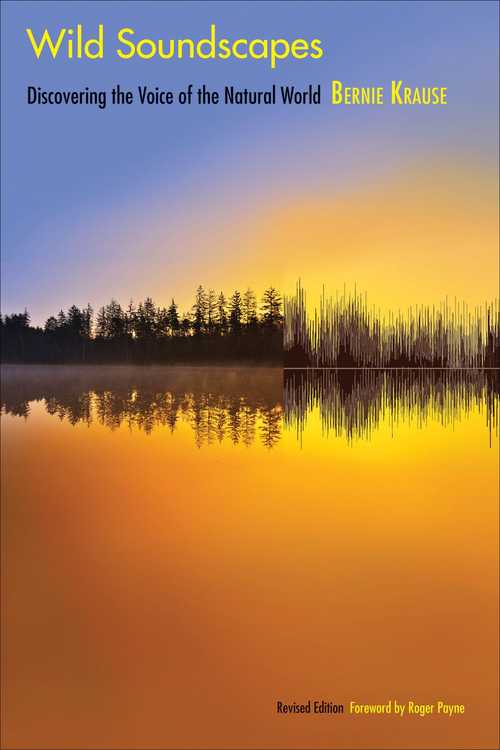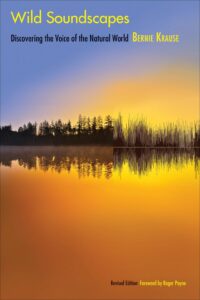
Following our article ‘Soundscape Ecology on Film’, earth.fm brings you the following run down of key texts providing a variety of perspectives on the world of nature sounds and soundscape ecology.
Ranging from classics in the field from pioneers like Bernie Krause and R. Murray Schafer, to modern titles building on the work of those forefathers, we hope that the titles below will provide illuminating insights and allow you to expand your engagement with the field.
1. Wild Soundscapes: Discovering the Voice of the Natural World by Bernie Krause (2002)

“Through his organization Wild Sanctuary, Bernie Krause has traveled the globe to hear and record the sounds of diverse natural habitats.” With Wild Soundscapes, it is possible to follow in his footsteps.
Though first published in 2002, this text by soundscape ecologist, musician, and author Bernie Krause has now been rewritten and updated to reflect advances in the field. Split into two, the first section encourages readers’ appreciation of the sounds of the natural world, while advocating for their preservation, before moving on to recording and editing techniques and ways to mix recorded sounds into “new expressions”. In addition, links are provided to sounds referred to in the text.
Professor, journalist, and fellow author (of The World without Us) Alan Weisman describes Wild Soundscapes as “part fascinating meditation on sound, part essential manual”, and a “veritable bible for how to record nature’s fleeting song”. For fellow journalist-author Richard Louv, it’s “a handbook and philosophical guide for anyone […] who wishes to open their senses to […] the sounds of the natural world”.
2. The Soundscape: Our Sonic Environment and the Tuning of the World by R. Murray Schafer (1977)
Like Bernie Krause, the name R. Murray Schafer – composer, writer, and educator – may well be familiar if you have spent time on earth.fm.

One of the fathers of the discipline, in this book Schafer offers philosophical musings on the perception of sound throughout history and its social and creative implications: the way the rise of the printing press and perspective painting during the Renaissance led to a visual representation of the Christian God overtaking a conception of Him “as sound or vibration”; the lack of complaints about the noises generated by the Industrial Revolution, which Schafer attributes to the contemporaneous “association of Noise and power”; or the way modern poetry is informed by the rhythms of motor vehicles and industrial machinery rather than that of hoofbeats.
Schafer also explores the past, present, and possible futures of the acoustic environment around us, the sonic complexity of which seems to constantly intensify, in a process he describes as, “An indiscriminate and imperialistic spread of more and larger sounds into every corner of man’s life”. Schafer posits that, ironically, this increased exposure to sounds deadens rather than hones our capacity for interpreting their complexities.
Therefore, he proposes that we classify sounds in order to discriminate between those which “enrich and feed us” and those which do not, and offers useful exercises for doing so. As The New York Times declares, following Schafer’s suggestions may “raise your consciousness of the soundscape to a level of sensitivity you never experienced before”.
👉 A PDF copy is available here.
3. The Sound Book: The Science of the Sonic Wonders of the World by Trevor Cox (2015)

Acoustic engineer Trevor Cox, Professor of Acoustic Engineering at the University of Salford and president of the Institute of Acoustics, “spent his career eradicating unwanted noises – echoes in concert halls, clamour in classrooms”. Then, one day, “he heard something so astonishing that he had an epiphany” (in the London sewers, of all places): that strange and unfamiliar sounds should be celebrated. Now, his “mission in life is […] to size up the world with his ears, to hear all the beguiling echoes, hisses and rumbles in far-flung locations we might never visit or at landmarks which, though familiar, remain hidden behind the smog of modern transportation noise and our own habitual inattention”.
The Sound Book – known as Sonic Wonderland: A Scientific Odyssey of Sound in the UK – is a product of that mission, and is itself based upon Cox’s website, Sonic Wonders (which aims “to identify places with unique sound characters and encourage people to become sonic tourists”). The book takes its readers on “a tour of the world’s most amazing acoustic phenomena”. From creaking glaciers to singing sand dunes and a road that plays the William Tell Overture – not to mention “whispering galleries, stalactite organs, […] seals that sound like alien angels, and a Mayan pyramid that chirps like a bird” – Cox now delights in the strangest sounds our world has to offer.
By dipping into disciplines as varied as archaeology, neuroscience, biology, and design, “Cox explains how sound is made and altered by the environment, how our body reacts to peculiar noises, and how these mysterious wonders illuminate sound’s surprising dynamics”.
👉 To compliment Cox’s “lucid and passionate case for a more mindful way of listening”, a range of ear-opening sounds are available here, to whet the aural appetite. (The bearded seals are a standout.)
4. The Sounds of Life: How Digital Technology Is Bringing Us Closer to the Worlds of Animals and Plants by Karen Bakker (2022)
“Technology often distracts us from nature, but what if it could reconnect us instead?” In attempting to answer this question, Karen Bakker – an author, researcher, and entrepreneur – seeks to use digital tools to re-engage humanity with the natural world.

The Sounds of Life outlines ways in which the cutting-edge technology of digital bioacoustic is being used to reveal and decipher communication taking place within the animal and plant kingdoms: for example, dictionaries being compiled of animal languages and dialogues being made possible with species like bees and bats under the auspices of digital technology; recordings of “healthy coral reefs [being played] to attract larval fish and coral to artificial reefs”; an AI algorithm trained to interpret whether tomato plants are dehydrated or wounded, according to the sounds they produce; or listening stations preventing vessel strikes against the critically endangered North Atlantic right whale.
“As it turns out, many non-human species produce and sense sounds, and with greater richness and complexity than we might have imagined” – yet further evidence of humanity’s failure to conceive of the sensitivities of other species. Across 10 chapters, each focusing on a specific organism, Bakker presents newly emerging insights about the communication of species such as bats (whose echolocation calls we now know incorporate baby-like babbling when young, “territorial songs in specific dialects” learnt from their fathers, and hundreds of context-specific calls as adults) and turtles (Amazonian sea turtles, “previously thought to simply abandon their eggs”, are now understood to call their hatchlings to safety).
Bakker includes interviews with the tenacious figures who have brought about these breakthroughs and discoveries – while also noting the mistrust with which they were initially received, prior to their acceptance by the broader scientific community. In particular, she makes a point of highlighting how Indigenous insights have been instrumental in many Global Northern scientific developments – such as the Indigenous Alaskan Iñupiat people’s proposal of acoustic surveys of bowhead whales, which proved far more accurate than the then-standard visual aerial surveys undertaken by Western researchers.
As it turns out, many non-human species produce and sense sounds, and with greater richness and complexity than we might have imagined.
“The whole world is communicating and singing. Even plants are in on the conversation. This astonishing book will forever change the way you hear the world” – so says Carl Safina, author of Beyond Words: What Animals Think and Feel. Bakker also speculates about possible outcomes of digital bioacoustics, such as real-time biodiversity monitoring and maybe even “a zoological version of Google Translate”. If these technologies do one day place the broader science of soundscape ecology into incontrovertibly practical applications, we may all hear and understand nature’s sonic world to a much deeper level. By expanding our understanding of other species’ capacities for nuanced communication, such developments would render our self-appointed position at the top of the animal kingdom even harder to justify.
5. In the Field: The Art of Field Recording by Cathy Lane and Angus Carlyle
This title comprises 18 conversations with contemporary sound artists whose work incorporates field recordings, but which cuts across subjects such as academia, geography, and anthropology.

Lane and Carlyle, respected cross-disciplinary field recordists in their own right, are co-directors of Creative Research in Sound Arts Practice (CRiSAP) – “a research centre of the University of the Arts London dedicated to the exploration of the rich complexities of sound as an artistic practice”, founded in 2005 and now a international leader of research into sound arts practice. By speaking to such a range of artists, they are able to track the way that, since being initiated by Ludwig Koch in 1889, wildlife field recording has developed “into a diverse range of practices which explore and investigate aspects of the lived environment, from the microscopic to the panoramic”.
Interviewees include established artists such as “composer and academic musician” Annea Lockwood, avant-garde experimental musician/sound artist Francisco López, and composer, teacher, and sound ecologist Hildegard Westerkamp, while also giving space to upcoming practitioners, such as “micro-sound enthusiast” Hiroki Sasajima. All of the subjects’ backstories and motivations are investigated, along with questions on subjects such as the ethics of what can be recorded, methods of distribution, esthetic preferences, and how they approach their own presence in recordings.
Writer and artist Rob St John states that the portraits which arise of practitioners’ idiosyncratic and highly varied approaches to their recordings means that “sound emerges from this book as a fluid, expressive and highly descriptive medium to work with”. He also notes that, despite many “contributors work[ing] within the abstracted realms of academia and conceptual art”, their responses are predominantly delivered in accessible language, and highlight the fundamental necessity of listening over expensive equipment.
In the Field is also keen to make the point that advances in recording equipment have democratized field recording, making it largely accessible to all – demystifying what ArtReview describes as a discipline “shrouded in […] mystery and myth […] [emblematized by] the enduring romantic image is of a lone individual poised, microphone in hand, to record the exquisite sonic output of some rare natural event”.
The end result is a text which Sonic Field – a “bilingual, interdisciplinary network devoted to the arts, studies and technologies of sound” – characterizes as “a valuable resource” and “one of the most inspiring books on field recording/listening”.
Earth.fm is a completely free streaming service of 1000+ nature sounds from around the world, offering natural soundscapes and guided meditations for people who wish to listen to nature, relax, and become more connected. Launched in 2022, Earth.fm is a non-profit and a 1% for the Planet Environmental Partner.
Check out our recordings of nature ambience from sound recordists and artists spanning the globe, our thematic playlists of immersive soundscapes and our Wind Is the Original Radio podcast.
You can join the Earth.fm family by signing up for our newsletter of weekly inspiration for your precious ears, or become a member to enjoy the extra Earth.fm features and goodies and support us on our mission.
Subscription fees contribute to growing our library of authentic nature sounds, research into topics like noise pollution and the connection between nature and mental wellbeing, as well as funding grants that support emerging nature sound recordists from underprivileged communities.

